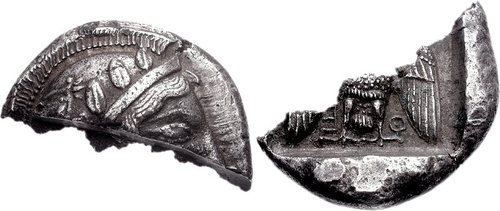
Dekadrachm Cut Fraction / Published in Starr
Description
CNG 76, Lot: 3049.
Estimate $10000. Sold for $23000. This amount does not include the buyer’s fee.
ATTICA, Athens. Circa 467-465 BC. AR Dekadrachm Fragment (21.11 g, 7h). Head of Athena right, wearing single-pendant earring, necklace, and crested Attic helmet decorated with three olive leaves over visor and a spiral palmette on the bowl / Owl standing facing, wings spread; [olive sprig and crescent to upper left]; all within incuse square. Starr group II.C, 56 (O50/R53) = C.M. Kraay & P.R.S. Moorey, “Two fifth century hoards from the Near East,” RN 1968, p. 185, 41 (this coin); Seltman 445-452; BMC 40 = ACGC 188; Kraay & Hirmer 357-8. Good VF, toned.
From the John A. Seeger Collection. Ex Jordan 1967 Hoard (ICGH 1482).
One of approximately 33 known today, with 18 in museum collections, eight in private collections, and seven whose locations are currently unknown. This example, weighing almost exactly half the full dekadrachm weight, is the only known fragment.
The historical context of the Athenian dekadrachms, as well as concomitant tetradrachms and didrachms of the same class, has been the matter of extended debate. Much of the early confusion stems from a passage in Herodotos, who said that Athens paid ten drachms to each of its citizens for surpluses from the Laurion mines (7.144.1). Early numismatists interpreted this as the occasion for the dekadrachm issue. The context of this passage in Herodotos, however, would place such an issue shortly after the victory at Marathon in 490 BC, a date that does not comport with the current hoard evidence. Neither does the view of early prominent numismatists, such as E. Babelon, who popularized the idea that the dekadrachms were struck in commemoration of the battle of Salamis (Traité II, col. 770). Although he discounts Babelon’s conclusion, Seltman, in his major work on the pre-Persian coinage of Athens, also placed the issue far too early, in the later 480s BC. Another confusion stems from early interpretations of the dekadrachms’ purpose. Head, much of whose work had formed the basis of later knowledge, thought they were special, ceremonial issues struck at various times for "the personal gratification of Tyrants or Kings", and were not part of the actual currency.
These earlier views have been completely superseded by modern scholarship. Starr's survey of the Athenian coinage, the seminal work for our current understanding of these coins, conclusively disproved such prior misconceptions. His conclusions, echoed by C. Kraay (ACGC, pp. 66-68) and confirmed by the “Dekadrachm Hoard”, confined all of the dekadrachm issues to a short period in the early- to mid-460s BC. It seems clear that such an exceptional and compact issue must have served some special function, but the nature of that function remains elusive. Key historical events during this period that could have produced sizable quantities of silver for this series are the battle of the Eurymedon River in 467 BC, where the resulting captured Persian booty was enormous and was attested to have been distributed (Plutarch, Vit. Cim. 13.6-8), and the capture of Thasos and its mines in 463/2 BC, where the plunder is assumed to have been substantial (Plutarch, op. cit. 14.2).
The dekadrachms stand apart from the typical Athenian coinage not only by their massive size, but the transformation of the reverse type from an owl in profile to one facing the viewer. One cannot fail to notice the power in such a portrayal, which clearly is a representation of the growing Athenian military might that produced the victory over the Persians at the Eurymedon River and the later capture of the bountiful Thasian mines.